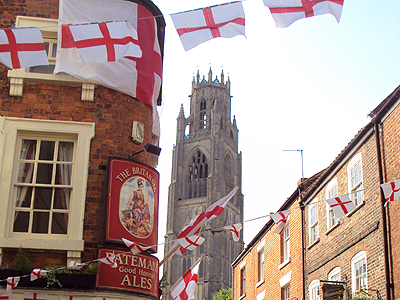- Black Death
- Boer War
- Civil War
- First World War
- Rise of the Puritan Movement
- Road to American Independence
- Shaping of Australia
- Second World War
- Apostrophe Protection Society
- Images of Boston Past
- Pictorial History of Boston
- Boston and the Foundation of the USA
- Notes in England and Italy by Mrs Hawthorne (1871) - Boston
- Our Old Home: A Series of English Sketches by Nathaniel Hawthorne (1883) - Boston
- Mayors of Boston 1545 - Present
- British History Books
Welcome to Boston
 Boston is situated near the south-east coast of Lincolnshire, where the River Witham becomes the Haven on its short journey to The Wash. The town is approximately 120 miles directly north of London and 32 miles south-east of Lincoln.
Boston is situated near the south-east coast of Lincolnshire, where the River Witham becomes the Haven on its short journey to The Wash. The town is approximately 120 miles directly north of London and 32 miles south-east of Lincoln.
The town has a population of around 35,400 with the Borough of Boston, which incorporates eighteen parishes, covering an area of approximately 139 square miles (35,992 ha) much of which is rich agricultural 'fenland'.
As with much of Lincolnshire, the area is just a few metres above sea level and regular flooding is only prevented by a system of drainage and sea defences. It is an historic and attractive market town which is dominated by the 14th-century St.Botolph's Church whose 271ft high tower is a landmark for miles around. There is a great deal of modern development being attracted into the town, which is a busy commercial and retail centre, and it is undergoing ongoing development as a longer-stay tourist destination.
Historically the agriculture industry provided the main employment and Boston's economy is still heavily dependent on agriculture and related employment. However, this sector is subject to ongoing decline whilst there is an increase in the manufacturing and service industry. The 1996 Annual Employment Survey showed that 11.1% of employees in the "Boston Travel To Work Area" worked directly in agriculture, compared with 1.4% nationally. The main type of agriculture in the Borough is vegetable production. The breakdown of employees and self employed by occupation for Boston, compared with the County, the Region and nationally shows a lower level of professional jobs. As at the 1991 census the Borough had 3,400 self-employed persons (13.1% of all in employment) compared to 40,353 (14.4%) at a County level.
The Port of Boston was established in 1886 and has a long history of handling agricultural and timber products. Following the Port’s privatisation in 1990 operations were expanded to handle steel imports from Northern Europe, primarily for the car industry in the UK, in addition to a dedicated terminal for paper imports from Norway. The development of a sophisticated container handling operation means that the Port now handles approximately 1.5 million tonnes of cargo per annum. The Port of Boston’s new rail link sees two trains a week, carrying 1,000 tonnes of steel per train, to operate from Boston to a dedicated facility in Birmingham. The Port has regular container services operating to Norway, Sweden and Spain with overall some 750 vessels per annum being handled through the Port. General trades are the import of animal feeds and timber in addition to up to half a million tonnes of grain exports per annum.
The name Boston is believed to be a derivation of St.Botolph's Town. St.Botolph was a 7th-century monk who is alleged to have founded an abbey here in 645AD although there is little evidence to support this.













